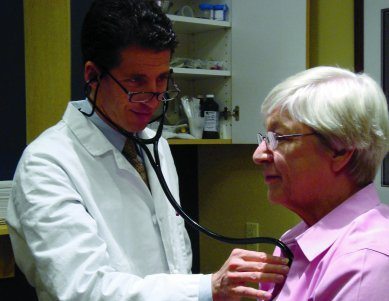By Kerry Duff
When Margret Thomas of Tucson was suffering from an agonizing headache in the middle of the night, her husband, Harold, called their primary care physician on his cell phone. The doctor met them at the hospital and an hour later she was in surgery having a brain aneurysm removed. Without the surgery, Margret would have died.
The Thomases were able to reach their doctor after hours because they contract directly with Dr. Steven D. Knope, an internist and sports medicine expert in Tucson, for concierge medical care. The couple pays him an annual out-of-pocket fee in exchange for personalized medical services such as 24/7 accessibility by beeper or cell phone and house calls.
“My wife and I can’t live without Dr. Knope,” says 76-year-old Harold. “Whether we’re at home in Tucson, Cincinnati or somewhere else, we can call him day or night and he gets back to us in 10 minutes or less. That’s worth a lot to us. A concierge doctor is like having insurance.”
Knope has been a concierge physician in the Tucson area for eight years. He has 125 patients that pay $6,000, or $10,000 per couple for concierge care. The fee includes a two-hour comprehensive physical, stress test, full cancer screening, health and fitness consultation and a personalized exercise and nutrition program. The doctor also accompanies patients to see specialists, and if they are hospitalized, he is the attending physician at the hospital — not a hospitalist who is unfamiliar with their health care, he says.
“Concierge medicine is very much patient driven,” Knope says. “Patients want a different model of care today and they’re willing to pay for it. The difference between concierge medicine and fast-food medicine is that the concierge doctor has time to perform correctly. If a doctor only has seven minutes to deal with a complex patient, he can only do so much. Doctors need time with their patients to do a good job.”
Scottsdale internist and geriatric physician, Scott Bernstein, converted his 2,000-patient practice to concierge medicine in July. What pushed him in that direction, he says, were Medicare constraints and the rising costs of running his practice.
“I was being squeezed from both ends,” Bernstein admits. “Now my patients and I contract directly without the constraints of the Medicare program. I can see patients the same day they call and I have time to provide the type of care they need and I want to provide. I can also do house calls and telephone appointments, which are not covered by Medicare.”
Bernstein sent a letter to his patients in April to let them know he was converting to concierge medicine. Since then, more than 200 people have joined the practice and agreed to pay his $2,000 annual fee.
“It was very bold to make this kind of change after working so hard for 12 years to build my practice,” he says. “I had to say goodbye to 80 percent of my patients and that was scary. But now I couldn’t be more thrilled. I give my patients the time and care they need, and most nights I have dinner with my family, which never happened before.”
Douglas Liebman of Scottsdale, a longtime patient of Dr. Bernstein’s, says he fully supports this type of care, but had to carefully weigh the costs before making a decision.
“I had to think about this carefully because I already have a $2,500 annual payout to Blue Cross Blue Shield,” Liebman says. “But then I realized that staying with Dr. Bernstein was a quality decision at any cost because it concerns my health care. He is genuinely concerned about my well-being and that’s really important to me. I also like being able to reach him after hours and weekends. But what I like most is the house calls. In the world of medicine today, it’s amazing that a doctor will come to your house if you can’t make it to the office.”
Bernstein transitioned to concierge care with the help of Dr. Helene Wechsler, a family physician in Scottsdale, who after 15 years of being in private practice with four other doctors started her own concierge practice in 2004. Wechsler’s practice is limited to 300 patients who pay $2,000 ayear.Patients with children under 18 pay $1,000 annually per child.

“When I first started practicing 19 years ago, I scheduled patients for 30-minute appointments,” Wechsler says. “But when the healthcare system moved to managed care, I could only see each person 15 minutes or less. In that amount of time you can only treat part of a person and I like to treat the whole person. As a traditional family physician, I also had mountains of paperwork and stress. But I eliminated both when I reduced my patient load and stopped accepting insurance and Medicare. “My concierge practice is peaceful and happy, and when patients walk in the door it’s a pleasant experience,” she adds.





